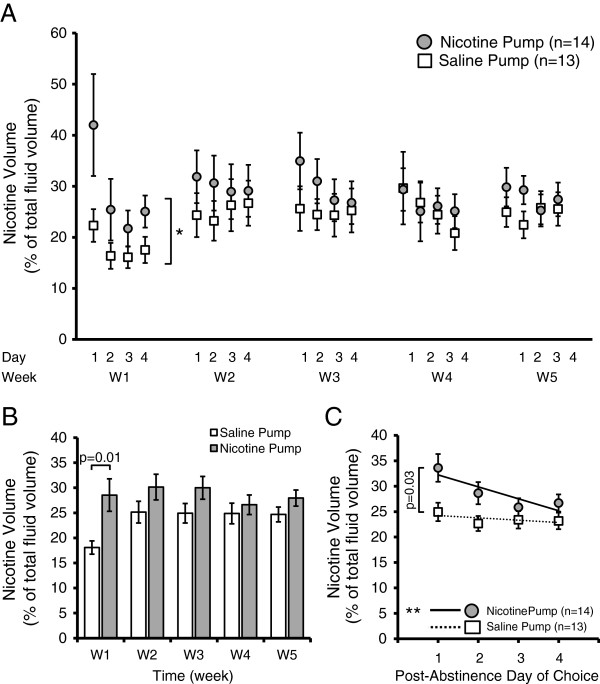Figure 7.

Mice pre-exposed with chronic nicotine self-administer a greater percentage volume of their daily fluid from the nicotine containing bottle in a two-bottle choice experiment. A) Mean nicotine volume intake as a percentage of total fluid volume during each period (days 1–4 during weeks 1–5) of two bottle-choice self-administration. Following 10 days of chronic drug administration via osmotic pumps (2 mg/kg/hr nicotine or saline), mice were subjected to five 7 day cycles of choice (4 days, two bottles: vehicle (0.2% saccharine) or vehicle + 200 μg/ml nicotine) followed by abstinence (3 days, single bottle roH2O). Mice primed with a nicotine containing pump self-administered more fluid from the nicotine bottle during most days of choice, though reached statistical significance only on W1 (*p = 0.0002, pump factor, two-way ANOVA; p = 0.01, Bonferroni post-hoc analysis). B) On a weekly basis, nicotine primed mice drink more fluid from their nicotine bottle than control saline primed mice, although significance was only achieved on W1 (p = 0.0002, pump factor, two-way ANOVA; p = 0.01, Bonferroni post-hoc analysis). C) Nicotine binge-drinking results from abstinence from nicotine self-administration. Percentage of daily fluid drank from the nicotine-containing bottle peaked on the first day following abstinence from nicotine self-administration and declined in subsequent days, a behaviour seen only in mice primed with a nicotine pump (day 1–4) (solid line: R2 = 0.76, **p = 0.01, linear regression,). Saline pump mice maintained a steady and lower percentage intake from their nicotine-containing bottle during each day of choice (dashed line: R2 = 0.36, *p = 0.19, linear regression). Furthermore, nicotine-pump mice self-administered significantly more nicotine compared to saline-pump mice on the first day following abstinence (p = 0.03, two sample t-test).
